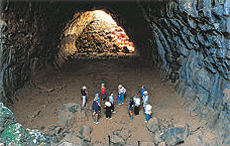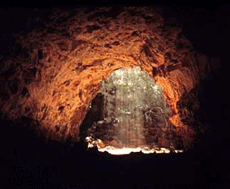
![]()

|
Location: Gulf Country, Queensland
Undara Lava Tubes (Undara Volcanic National Park) near the small town of Mount Surprise 275 km south-west of Cairns, are one of Australia's great geological wonders. They are the largest, longest and most accessible lava tubes on earth. The tubes contain creatures previously unknown to science, including two species of insect-eating bats. Unique blind insects and colourless shrimps and beetles have evolved without need for the sense of sight or colour camouflage in the black basalt tubes. Two new snail varieties are among the 24 cave-adapted species thus far discovered.
Undara volcano erupted 190,000 years ago and spewed 23 cubic kilometres of molten lava onto the surrounding country. Streams of sulphurous lava flowed over the land, spilling out like boiling treacle into various creek beds and other depressions. The surface soon cooled and crusted but the molten lava inside continued to flow, leaving behind the huge hollow pipes ... the unique lava tubes.
From the air, these rich canopies create a distinct path following the lava flow that occurred 190,000 years ago, when the Undara Crater, one of many on the McBride Plateau, erupted. Seventeen cubic miles (23 km3) of fiery molten lava spewed from Undara. The exterior lava quickly cooled and crusted, whilst the interior lava drained beneath the crusted exterior to leave long, dark, hollow tubes. Ancient roof collapses have since created the fertile pockets in which rainforest plant, insect and animal species now thrive ... and which visitors can now explore. By the time the volcano subsided, over 160 kilometres of lava flow streaked the countryside and the 20 metre diameter tubes had been formed.
Over time the roof of the tubes collapsed in places, leaving fertile soakages that sheltered ancient Gondwanaland rainforest from the bushfires. Remnant vine thicket in the soakages is found elsewhere only in Madagascar and East Africa. From the air, the pockets of dark green rainforest make the tube line stand out in stark contrast to the vast golden Savannah country that stretches to the horizon on all sides. In 1993 the Queensland Government proclaimed the area as the Undara Volcanic National Park but retained the Collins family to protect the park, as it has done so well for over 130 years. The Undara Lava Lodge, offers unique accommodation in turn-of-the-century carriages, as well as other accommodation options to suit all budgets.
Several of the tubes, or "caves" as they are often called now, are open to the public (others are still the subject of scientific research) but only on guided tours conducted by Lodge owner Gerry Collins or one of the friendly and knowledgeable guides who are all members of the Savannah Guides Organisation. Savannah Guides is a system of professionals who man Guide Stations in some of North Australia's most spectacular wilderness regions. Besides being master interpreters with an intimate knowledge of their specific environments, they are also protectors of their specific locations.
The park is also home to a wonderful kaleidoscope of bird life, of which over 150 species have been recorded. Barkers tube has become the bats' favoured "maternity and baby nursery". For some months each year, the pregnant females retire there to give birth and nurture their young; as many as 100,000 bats can be in the "nursery" at any one time. During those months, the 682 metre Barkers is closed to visitors.
Perhaps the most spectacular stop is the Archway. Here dozens of butterflies flit about your head as you scramble over rocks and pick your way through tangles of vines and fig trees. The latter's long, determined roots work in defiance of the solid lava, breaking through it in the eternal search for water and nutrients. Fibrous roots stretch down from ancient trees overhead, towards the underground soaks found in the lava tubes.
Eighteen metres below ground level at the tube's entrance, the temperature is decidedly cooler and there is the pungent smell of underground life. Over time, bat guano has accumulated with silt and leaf litter to form a false floor which in places achieves a thickness of 6.5 metres.
View Larger Map
|